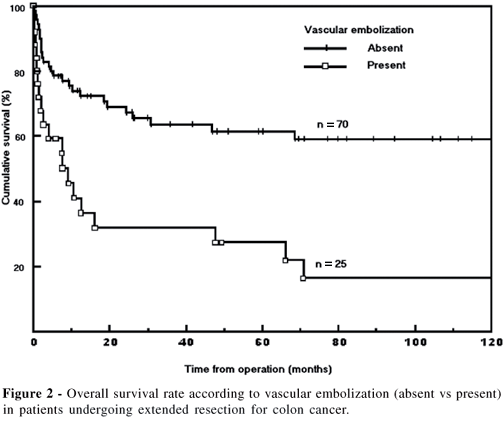Foi avaliado o impacto de variáveis clínicas, patológicas e cirúrgicas na morbidade e mortalidade pós operatórias de pacientes submetidos à ressecção extendida de carcinoma do cólon. MÉTODOS: Prontuários médicos de 95 pacientes submetidos á ressecção extendida de carcinoma de cólon entre os anos de 1953 e 1996 foram revisados. Em todos os casos, além de colectomia, um ou mais órgãos e/ou estruturas foram ressecados em bloco devido á suspeição de invasão tumoral macroscópica. As variáveis clínicas, patológicas e cirúrgicas foram analizadas. As taxas de sobrevida global foram analizadas de acordo com o método de Kaplan and Meier. A análise multivariada foi realizada empregando-se o modelo de risco proporcional de Cox. RESULTADOS: Oitenta e seis pacientes foram tratados com cirurgia curativa e o restante com ressecção paliativa. Invasão microscópica de órgãos e/ou estruturas adjacentes e linfonodos regionais foi encontrada em 48 e 31 pacientes respectivamente. O tempo de seguimento mediano, sem mortalidade pós operatória, foi de 47.7 meses. A taxa de sobrevida global em 5 anos foi de 52.6%. A taxa de sobrevida global para pacientes submetidos à cirurgia curativa e paliativa foi de 58.3% e zero, respectivamente. A sobrevida mediana no grupo de pacientes com cirurgia paliativa foi de 3.1 meses. A análise multivariada mostrou que a performance status de Karnofsky fortemente correlacionou com risco de complicações pós operatórias (p=0.01), e que o risco de morte pós operatória estava associada com o tipo de cirurgia e a performance status de Karnofsky na admissão (p=0.001) CONCLUSÕES: Pacientes com adenocarcinoma de cólon localmente avançados submetidos à ressecção extendida têm taxa de sobrevida global em 5 anos de 58.3% Este tipo de cirurgia pode ser empregada com intuito paliativo, mas deve ter indicação criteriosa e ser evitada em pacientes com baixa performance status de Karnofsky devido às altas taxas de mortalidade pós operatória e baixa sobrevida.
Cirurgia extendida; Ressecção en bloco; Câncer do colon; Mortalidade; Prognóstico







